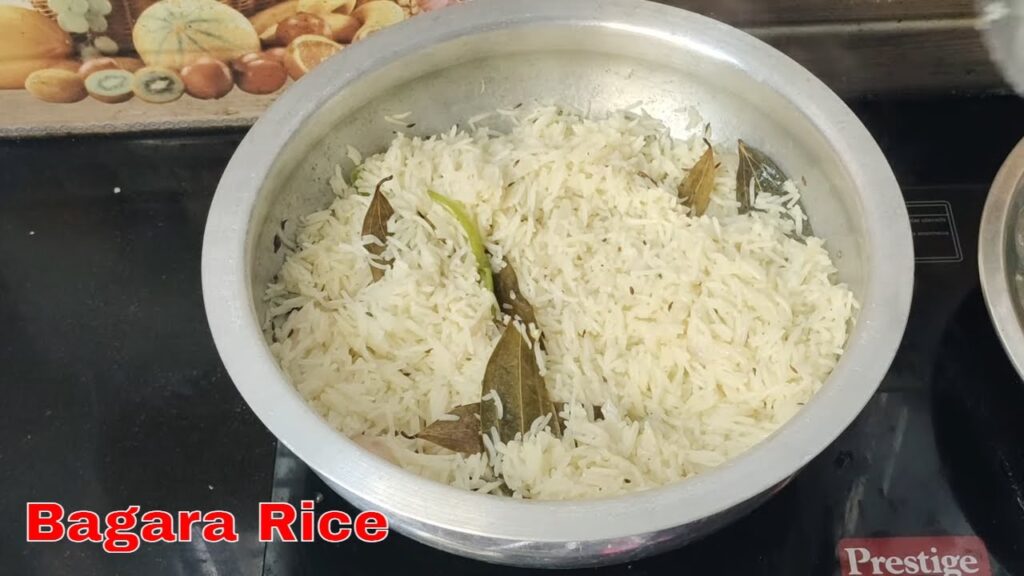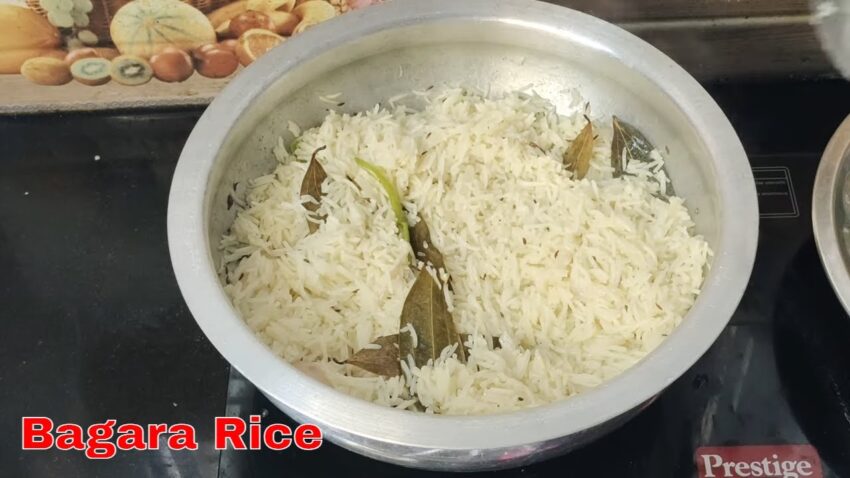
Bagara Biryani: The Definitive Guide to Hyderabad’s Aromatic Rice Delight
Bagara Biryani, a fragrant and flavorful rice dish originating from Hyderabad, India, is a culinary gem often overshadowed by its more famous cousin, Hyderabadi Biryani. This comprehensive guide delves deep into the intricacies of Bagara Biryani, exploring its history, ingredients, preparation methods, variations, and the secrets to achieving authentic taste and texture. Whether you’re a seasoned chef or a curious home cook, this article will equip you with the knowledge and confidence to master the art of Bagara Biryani. We aim to provide exceptional value, offering a deeper understanding than other online resources, reflecting our expertise and dedication to providing trustworthy information.
Understanding Bagara Biryani: A Culinary Masterpiece
Bagara Biryani, unlike Hyderabadi Biryani, is typically a milder, more subtly spiced rice dish. It’s characterized by its aromatic basmati rice, fragrant spices, and the use of ‘bagar’ – a tempering process where spices are fried in ghee or oil to release their flavors before being added to the rice. This bagar is the heart of the dish, infusing the rice with its distinctive aroma and taste. While often vegetarian, variations with chicken, mutton, or eggs are also popular.
The History and Origins of Bagara Biryani
While the exact origins are debated, Bagara Biryani is believed to have evolved as a simpler, everyday alternative to the richer, more elaborate Hyderabadi Biryani. It likely emerged in the kitchens of Hyderabad’s homes, where cooks sought a flavorful yet less time-consuming rice dish. Its simplicity and adaptability have made it a staple in Hyderabadi cuisine.
Key Ingredients and Their Significance
The essential ingredients of Bagara Biryani include:
- Basmati Rice: The long-grain, aromatic rice is crucial for achieving the desired texture and fragrance.
- Ghee or Oil: Used for the bagar, ghee adds richness and a distinct flavor. Oil is a suitable alternative for a lighter dish.
- Whole Spices: Bay leaves, cardamom pods (both green and black), cloves, cinnamon sticks, and cumin seeds are essential for the bagar.
- Onions: Sliced and fried until golden brown, they add sweetness and depth of flavor.
- Ginger-Garlic Paste: A staple in Indian cuisine, it provides a pungent and aromatic base.
- Green Chilies: Add heat and a vibrant flavor.
- Mint and Coriander Leaves: Fresh herbs that provide freshness and aroma.
- Salt: To season the rice and other ingredients.
- Water or Vegetable Broth: For cooking the rice. Vegetable broth adds extra flavor.
Understanding the ‘Bagar’ Technique
The ‘bagar’ is the defining element of Bagara Biryani. This involves heating ghee or oil in a pan and frying the whole spices until they release their aroma. The fried spices are then added to the rice along with other ingredients, infusing the dish with its characteristic flavor. The key is to fry the spices gently to avoid burning them, which can impart a bitter taste.
The Art of Making Authentic Bagara Biryani: A Step-by-Step Guide
Creating authentic Bagara Biryani requires attention to detail and a good understanding of the cooking process. Here’s a step-by-step guide to help you master this delightful dish:
- Prepare the Rice: Wash the basmati rice thoroughly until the water runs clear. Soak it in water for at least 30 minutes. This helps the rice cook evenly and become fluffy.
- Prepare the ‘Bagar’: Heat ghee or oil in a heavy-bottomed pot. Add bay leaves, cardamom pods, cloves, cinnamon sticks, and cumin seeds. Fry until fragrant.
- Add Onions and Ginger-Garlic Paste: Add sliced onions and fry until golden brown. Then, add ginger-garlic paste and sauté for a minute until the raw smell disappears.
- Add Green Chilies and Herbs: Add chopped green chilies, mint leaves, and coriander leaves. Sauté for a few seconds.
- Add Water or Broth: Add water or vegetable broth to the pot. Bring to a boil.
- Add Rice and Salt: Drain the soaked rice and add it to the pot. Add salt to taste.
- Cook the Rice: Bring the mixture back to a boil, then reduce the heat to low, cover the pot tightly, and simmer for 15-20 minutes, or until the rice is cooked through and the water is absorbed.
- Rest the Rice: Once cooked, turn off the heat and let the rice rest for 10 minutes before fluffing it with a fork. This allows the steam to escape and prevents the rice from becoming mushy.
- Serve: Serve the Bagara Biryani hot with raita (yogurt dip) and your favorite curry or side dish.
Variations and Adaptations of Bagara Biryani
Bagara Biryani is a versatile dish that can be adapted to suit different tastes and preferences. Here are some popular variations:
- Vegetable Bagara Biryani: Add mixed vegetables like carrots, peas, beans, and potatoes to the bagar for a more substantial dish.
- Chicken Bagara Biryani: Add marinated chicken pieces to the bagar and cook until tender before adding the rice.
- Mutton Bagara Biryani: Similar to chicken, but with mutton pieces. Mutton requires longer cooking time, so ensure it’s tender before adding the rice.
- Egg Bagara Biryani: Add boiled and halved eggs to the cooked Bagara Biryani for a protein-rich meal.
- Spicy Bagara Biryani: Increase the amount of green chilies or add red chili powder to the bagar for a spicier flavor.
Bagara Biryani vs. Hyderabadi Biryani: Key Differences
While both are Hyderabadi rice dishes, Bagara Biryani and Hyderabadi Biryani differ significantly:
- Spices: Bagara Biryani uses fewer spices and is generally milder than Hyderabadi Biryani, which is known for its rich and complex spice blend.
- Cooking Method: Hyderabadi Biryani is often cooked using the ‘dum’ method, where the rice and meat are layered and cooked slowly under pressure. Bagara Biryani is typically cooked in a single pot.
- Flavor Profile: Bagara Biryani has a simpler, more aromatic flavor, while Hyderabadi Biryani has a richer, more intense flavor.
- Complexity: Bagara Biryani is generally easier and quicker to prepare than Hyderabadi Biryani.
Pairing Bagara Biryani: Perfect Accompaniments
Bagara Biryani pairs well with a variety of dishes. Here are some popular accompaniments:
- Raita: A yogurt-based dip with chopped vegetables and spices. It provides a cooling contrast to the flavorful biryani.
- Mirchi ka Salan: A spicy chili curry that complements the mildness of the Bagara Biryani.
- Baingan Bharta: A smoky eggplant mash that adds a savory element to the meal.
- Chicken Curry: A classic pairing that provides a protein-rich and flavorful addition.
- Mutton Curry: Similar to chicken curry, but with mutton.
The Health Benefits of Bagara Biryani (When Prepared Mindfully)
While traditionally made with ghee, Bagara Biryani can be prepared in a healthier way by using less oil or opting for healthier oils like olive oil or rice bran oil. The use of whole spices provides antioxidants and other health benefits. Adding vegetables can further enhance the nutritional value of the dish. Moderation is key, as with any rich food.
Bagara Biryani: A Taste of Hyderabad in Every Bite
Bagara Biryani is more than just a rice dish; it’s a culinary experience that transports you to the heart of Hyderabad. Its fragrant aroma, subtle spices, and fluffy rice create a symphony of flavors that is both satisfying and comforting. Whether you’re cooking for a special occasion or simply craving a delicious meal, Bagara Biryani is sure to impress.
Expert Tips for Perfecting Your Bagara Biryani
Achieving culinary perfection requires practice. Here are some expert tips that can help you elevate your Bagara Biryani:
- Use High-Quality Basmati Rice: The quality of the rice significantly impacts the final result. Choose long-grain, aromatic basmati rice for the best texture and flavor.
- Don’t Overcook the Rice: Overcooked rice will become mushy. Cook the rice until it’s just tender and the water is absorbed.
- Use Fresh Herbs: Fresh mint and coriander leaves add a vibrant aroma and flavor.
- Adjust Spices to Your Taste: Feel free to adjust the amount of spices to suit your preference.
- Rest the Rice Before Serving: Resting the rice for 10 minutes after cooking allows the steam to escape and prevents it from becoming mushy.
Bagara Biryani and the Restaurant Industry
Many restaurants, particularly those specializing in Hyderabadi cuisine, offer Bagara Biryani on their menus. The quality and authenticity can vary widely. Look for restaurants that use fresh ingredients, traditional cooking methods, and have positive reviews. Some restaurants offer variations with different meats or vegetables, catering to a wider range of preferences.
Bagara Biryani: A Cultural Icon
Bagara Biryani is deeply embedded in Hyderabadi culture, often served at family gatherings, celebrations, and festive occasions. It’s a symbol of hospitality and a testament to the region’s rich culinary heritage. Sharing a plate of Bagara Biryani is a way to connect with loved ones and celebrate the flavors of Hyderabad.
Insightful Q&A: Your Bagara Biryani Questions Answered
Here are some frequently asked questions about Bagara Biryani, answered with expert insights:
-
Q: Can I make Bagara Biryani in a rice cooker?
A: Yes, you can, but the flavor might not be as intense as when cooked in a pot. Follow your rice cooker’s instructions, but add the bagar ingredients to the rice cooker before adding the rice and water.
-
Q: How can I prevent the rice from sticking to the bottom of the pot?
A: Use a heavy-bottomed pot and ensure there’s enough water or broth. Cooking on low heat and avoiding frequent stirring also helps.
-
Q: Can I use brown rice instead of basmati rice?
A: While you can, the texture and flavor will be different. Brown rice requires more water and a longer cooking time. Adjust the recipe accordingly.
-
Q: How long does Bagara Biryani last in the refrigerator?
A: Properly stored, Bagara Biryani can last for 2-3 days in the refrigerator.
-
Q: Can I freeze Bagara Biryani?
A: Yes, you can freeze it for up to 2-3 months. Thaw it overnight in the refrigerator before reheating.
-
Q: What’s the best way to reheat Bagara Biryani?
A: Reheat it in a microwave or on the stovetop with a splash of water to prevent it from drying out.
-
Q: Can I make Bagara Biryani without ghee?
A: Yes, you can use oil instead. However, ghee adds a distinct flavor that is characteristic of Bagara Biryani.
-
Q: What if I don’t have all the whole spices?
A: Use what you have, but try to include at least bay leaves, cardamom, cloves, and cinnamon for the best flavor.
-
Q: How can I make my Bagara Biryani more flavorful?
A: Use vegetable broth instead of water, add more spices, or marinate the meat or vegetables beforehand.
-
Q: Is Bagara Biryani suitable for vegetarians?
A: Yes, the basic recipe is vegetarian. You can add vegetables to make it more substantial.
Conclusion: Embrace the Aromatic World of Bagara Biryani
Bagara Biryani is a testament to the beauty of simplicity and the power of aromatic spices. This guide has provided you with a comprehensive understanding of this delightful dish, from its history and ingredients to its preparation methods and variations. We encourage you to experiment with different ingredients and techniques to create your own unique version of Bagara Biryani. Share your culinary creations and experiences with Bagara Biryani in the comments below. For further exploration of Hyderabadi cuisine, explore our other guides on related dishes. Contact our culinary experts for personalized guidance on perfecting your Bagara Biryani and other Hyderabadi specialties.

